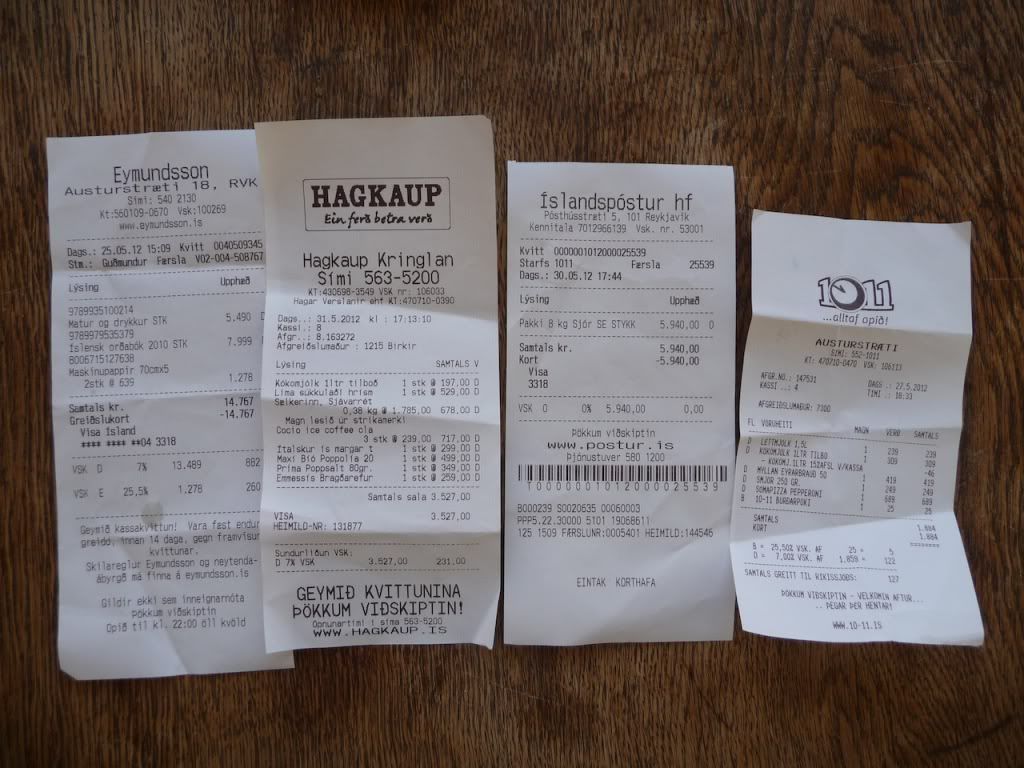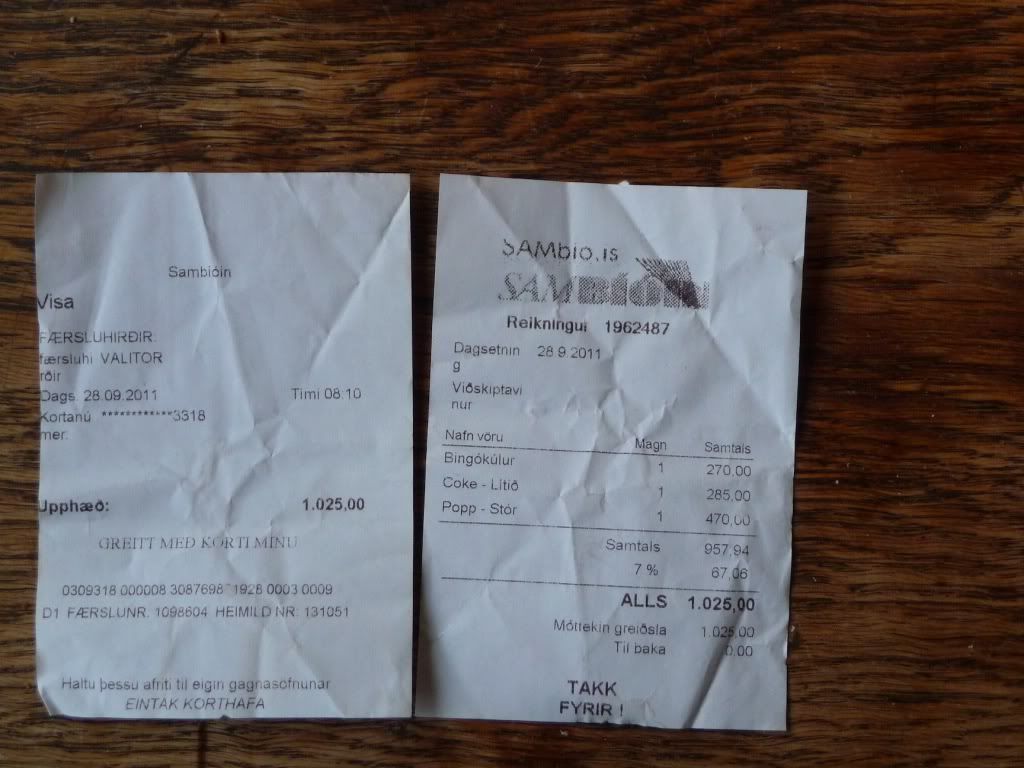Reading Receipts Posted by sequoia on Jul 10, 2012 in Icelandic customs
If you ever go to Iceland, a fun souvenir is your shopping receipts. They’re almost always in Icelandic and there are two main types with slight variations. You can also get other receipt types from various more unique events and places.

The first type is the real receipt. This shows the items that you bought. At the top is the name of the store (pictured is a bookstore, grocery store, post office, and convenience store) then the cashier’s information, then the items you bought, and at the end tends to be some kind of note such as “save your receipt!” or the opening hours. Additionally, on post office receipts sometimes the tracking code for your packages is printed on them.
Kt. (kennitala) – social security number
VSK (virðisaukaskattur) – VAT (Value-Added Tax)
nr. (nummer) – number
dags. (dagsetning) – date
kassi – cash register
afgreislumaður – customer service person
lýsing – description
magn – amount
verð – price (often meaning “individual price”)
upphæð – amount, sum
samtals – total
tilboð – sale
stk. (stykki) – piece (often meaning more like “each” or “a single piece” in terms of wares, such as a single piece of candy from a box full of candies)
kort – card
greislukort – payment card (credit/debit card)
kvittun – receipt
The second type is your credit/debit card receipt, you only get this if you paid via card. I don’t have photos of those, but they don’t have any special information on them anyway.

Queue machine receipts. Queue machines are little ticket machines where you take a number and wait for your turn. They’re extremely common and you’ll see them at the bank, post office, government offices, and sometimes even more normal places like bakeries. Usually they have English as a dual language on the options, and not just Icelandic. Most of the ones I’ve seen are electronic instead of manual, so you press a button and the ticket comes out instead of tugging at it and ripping it off yourself.
afgreiðsla – service
glerauga – glasses
verslun – store
almennur – “common, universal” but often means “general”, such as “general service” and “general public”. Sometimes in the “general public” sense it actually means more like the general Icelandic public, such as the price of an Icelander paying for medicine versus the price of a non-resident/tourist.
RSK (Ríkisskattstjóri) – the tax office

Movie theater tickets.
Nafn vöru – name of wares
At the bottom of most receipts you can see a percentage. That’s a tax percentage (sometimes there are two at once) and a part of that is what you can get back if you buy over a certain amount at one store and live abroad (nicknamed “tax-free”), but we won’t go into that here. Occasionally you may get a different kind of receipt, such as a handwritten one or one made on carbon paper. I don’t have photos of those as they have my personal information directly on top of most of the Icelandic text, so unfortunately the Icelandic is too muddled to see.
When paying via card you’ll usually have to sign (“undirskrifa/undirrita”) a receipt for the store to keep, then they’ll give you your own copy of the receipt. They don’t need your PIN number to use your card, but credit cards in Iceland have some kind of “magnet” (I assume this actually refers to some kind of computer chip, but it’s an example of the average Icelander’s English – it’s a mistake I’ve heard a few times) that their card readers use to get your information. So if your card doesn’t have one of those, occasionally you’ll have problems and the teller might have to input your card number manually.

Miði – sometimes used for “receipt” and means “slip of paper”, but it’s often used as “ticket”.
Here is a concert ticket and a parking payment receipt. On the parking receipt you can see the logo of the city of Reykjavík, but I’ll cover that in a later post. As you can see, these look very different from store receipts but they use some of the same vocabulary so you can probably still puzzle out some of the information.

Build vocabulary, practice pronunciation, and more with Transparent Language Online. Available anytime, anywhere, on any device.
About the Author: sequoia
I try to write about two-thirds of the blog topics on cultural aspects and one-third on the language, because there's much more out there already on the language compared to daily life information. I try to stay away from touristy things because there's more of that out there than anything else on Iceland, and I feel like talking about that stuff gives you the wrong impression of Iceland.



